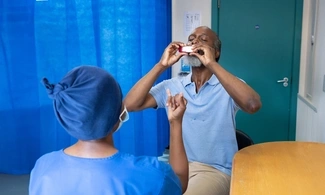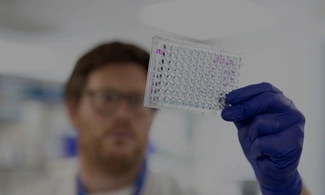Ask your healthcare professional to test you for NTM if you live with a lung condition or have a weak immune system and have symptoms of an infection that:
will not go away, or
are getting worse despite your usual treatment.
Some people have told us that it can be difficult to get healthcare professionals to agree to test for NTM. You may find it helpful to prepare for your appointment by writing down your symptoms and any questions you’d like to ask. If you’re still feeling worried or would like more support, you can also consider getting a second opinion.
What is NTM?
Non-tuberculous mycobacteria, or NTM, is a group of bacteria that can cause lung infections. These infections are sometimes called NTM pulmonary disease (NTM-PD). NTM infections are rare. In the UK, there are around 7 cases in 100,000 people.
NTM can cause health problems for anyone, but they’re more likely to affect those with a weak immune system or lung condition, like:
NTM are part of the same family of bacteria that cause tuberculosis (TB), but NTM do not cause TB.
Where does NTM come from?
NTM are found in water and soil. We all come into contact with these bacteria in our daily lives. There are lots of different species of NTM.
Tips to avoid NTM in water and soil
You cannot completely avoid NTM but there are some things you can do to reduce your exposure. Tips to avoid these bacteria include:
-
Increase your water heater temperature to above 55 degrees Celcius. This helps prevent NTM growing in your water. If you increase your water temperature, make sure to use a thermostatic mixing valve to avoid burns when handwashing and showering.
-
Take short showers and clean your showerhead regularly.
-
Place a water filter in your shower.
-
Open a window in your bathroom when you shower, or use an extractor fan.
-
Only drink boiled or filtered water. If you boil your water, let it cool down before drinking it.
-
Avoid dust from soil by keeping the soil moist and wearing a face mask when you’re gardening.
There’s no clear evidence that things like stopping gardening, not showering or giving up swimming reduce the risk of getting an NTM infection.
What are the symptoms of NTM lung infections?
Symptoms may develop slowly and may include:
-
a cough, and coughing up phlegm or blood
-
a high temperature of 38 degrees Celcius or above (fever)
-
losing weight and not feeling hungry
-
feeling very tired (fatigue)
-
feeling breathless more often
-
night sweats.
Your symptoms may be similar to other common lung infections or lung conditions. For example, if you’re living with bronchiectasis or COPD, you may experience a cough, produce phlegm and feel tired. If the symptoms of your existing lung condition get worse, this is often a flare-up (exacerbation) of the condition itself. But, if you have long or repeated flare-ups of your condition, you should ask your healthcare professional if this could be an NTM infection.
Can I pass on an NTM infection to someone else?
There is no evidence that you can pass an NTM infection to someone who does not have a lung condition or a weak immune system. It’s also extremely rare for NTM infections to be passed between people with existing lung conditions. If you have any type of infection, always cough into a tissue, throw it away straight away and wash your hands.
How is NTM infection diagnosed?
It can take time to diagnose an NTM infection. Your healthcare professional will ask you about your medical history and you’ll need to have some tests, such as:
|
Test you might need |
Why? |
|
A phlegm (sputum) sample |
To see if you have NTM in your airways. |
|
To see what pattern of lung disease you have and if you have any other lung problems. |
|
|
To measure how much air you can breathe out in one forced breath. It helps to show how well your lungs are working. |
|
|
FeNO (fractional exhaled nitric oxide) test |
To measure inflammation in your airways. |
|
To understand more about your lung function and see if you might be suitable for treatment. |
If you do not cough any phlegm up, you may need to have a bronchoscopy to get a sample.
Even if NTM are found in your phlegm, it does not mean you have an NTM lung infection. You may not always need treatment, as some people can clear the infection without needing antibiotics. Your doctor will explain your test results to you and discuss whether you need treatment.
How is NTM infection treated?
If you’re diagnosed with an NTM infection, your specialist team will monitor you closely. Often a specialist nurse will be assigned to you, and other healthcare professionals like physiotherapists and dietitians may be involved too. NTM infections can last for a year or two as the bacteria gets trapped by the phlegm in your lungs. Chest clearance and regular exercise can help to improve your symptoms without needing to take antibiotics. You could try our Keep Active programme to help you get active at home.
But your healthcare professional may want to treat your infection with antibiotics if:
-
you continue to have symptoms
-
there is evidence of lung damage, for example if a CT scan shows inflammation in your lungs or widening airways.
You’ll be treated with a combination of several antibiotics, which often include:
-
Rifampicin
-
Ethambutol
-
Azithromycin
-
Clarithromycin
-
Amikacin
-
Isoniazid.
You’ll usually take these antibiotics as tablets or liquid. It takes a long time to kill all the NTM bacteria, so you may be treated for a year or two. If you take all your medication as prescribed, the infection should go.
Help your lungs fight off infection
The best way to help your lungs fight off an NTM infection is to keep active and look after yourself by:
-
getting any vaccines you’re able to, for example flu and pneumonia
-
eating a healthy balanced diet
-
taking your medicines as prescribed
-
doing your chest clearance exercises regularly if you have bronchiectasis or cystic fibrosis
-
avoiding people with chest infections and respiratory infections like colds or covid
-
getting help to stop smoking.
Can NTM infections come back?
NTM infections can come back. If you think your infection is coming back, it’s important to see your healthcare professional.
If you forget or stop taking your NTM infection medicines, the infection may return.
This is serious because:
-
if you do not take your medicines regularly the NTM bacteria can become resistant to the antibiotics you were taking, making your infection much harder to treat
-
you may need to take more medicines
-
bacteria can still exist even after samples come back negative
-
you may need to have injections or nebulisers as well as tablets.
If you are having problems taking your medicines as prescribed, speak with your specialist or another health care professional.
What are the side effects of treatment for NTM infection?
Like any medicine, the antibiotics used to treat NTM infections can cause side effects. You may experience different side effects depending on the medication you’re taking. Always talk to your healthcare professional if you have side effects.
Very common side effects of NTM treatment
If you are taking Rifampicin, more than 1 in 10 people may experience:
-
a change in the colour of your urine, saliva, sweat or tears, usually to a red-orange colour - this is harmless.
Common side effects of NTM treatment
Around 1 in 100 to 1 in 10 people may experience these side effects. You should contact your health care professional if you experience any of these for more than 48 hours:
-
vomiting (being sick)
-
nausea (feeling sick)
-
diarrhoea
-
loss of appetite.
Rare side effects of NTM treatment
Around 1 in 10,000 to 1 in 1,000 people may experience these side effects. You should contact your health care professional immediately if you experience any one of these:
-
eyesight problems such as blurry vision or pain in the eyes (this can occur with Ethambutol treatment)
-
rash or itchy skin
-
chills or a high temperature (38 degrees Celsius or above)
-
bruising more easily
-
liver problems such as yellowing skin (jaundice)
-
numbness or tingling in your fingers or toes.
Whilst you’re taking a combination of different antibiotics to treat your NTM infection, your specialist team will monitor your symptoms carefully. They may ask you to take tests, like:
|
Test you might need |
Why? |
|
To see if you have any heart problems. |
|
|
To see if you have any liver or kidney problems. |
|
|
To see if your treatment is affecting your hearing. |
|
|
Eye test |
To see if you have any changes to your eyesight. |
Useful resources
Other useful resources for people living with NTM infections:
-
NTM Patient Care UK – provides information and support for people with non-tuberculous mycobacterial (NTM) infections.

Get support
Call or email our helpline for support with your condition. Get advice on medicines, symptoms or travelling with a lung condition. You can also find support through our groups.








